2
Video summary
In a nutshell
Under what circumstances might the adoption of labor-saving technology lead to extreme social instability? This policy brief examines the case of the Captain Swing riots in the industrializing England of the 1830s, bringing new insights to this old episode by collecting original data on the diffusion of the threshing machine, an innovation that led to severe labor unrest in wheat-growing parts of the country. The evidence illustrates that while new technologies typically boost output overall, not everyone benefits – and the losers may not always suffer in silence. Societies need to find ways to cushion the blow of technological unemployment, perhaps by offering alternative work or providing minimum income guarantees.
Under what circumstances might the adoption of labor-saving technology lead to extreme social instability? This policy brief examines the case of the Captain Swing riots in the industrializing England of the 1830s, bringing new insights to this old episode by collecting original data on the diffusion of the threshing machine, an innovation that led to severe labor unrest in wheat-growing parts of the country. The evidence illustrates that while new technologies typically boost output overall, not everyone benefits – and the losers may not always suffer in silence. Societies need to find ways to cushion the blow of technological unemployment, perhaps by offering alternative work or providing minimum income guarantees.
Opportunities for action
1
New technologies may affect the distribution of output among the factors of production. They also increase overall production, so in theory everyone can gain. But this is not automatic, and labor-saving technologies will leave workers worse off if left unchecked.
2
For societies to adopt technology more effectively, they need ways to cushion the potential blow. Institutions of the welfare state may contribute to preventing unrest, just as in 1830s England, the embryonic provision for the disadvantaged helped to keep the social peace.
3
Outside options also matter in terms of opportunities for alternative employment. When workers can easily find work elsewhere, they may more readily accept the introduction of new technologies.
1
New technologies may affect the distribution of output among the factors of production. They also increase overall production, so in theory everyone can gain. But this is not automatic, and labor-saving technologies will leave workers worse off if left unchecked.
2
For societies to adopt technology more effectively, they need ways to cushion the potential blow. Institutions of the welfare state may contribute to preventing unrest, just as in 1830s England, the embryonic provision for the disadvantaged helped to keep the social peace.
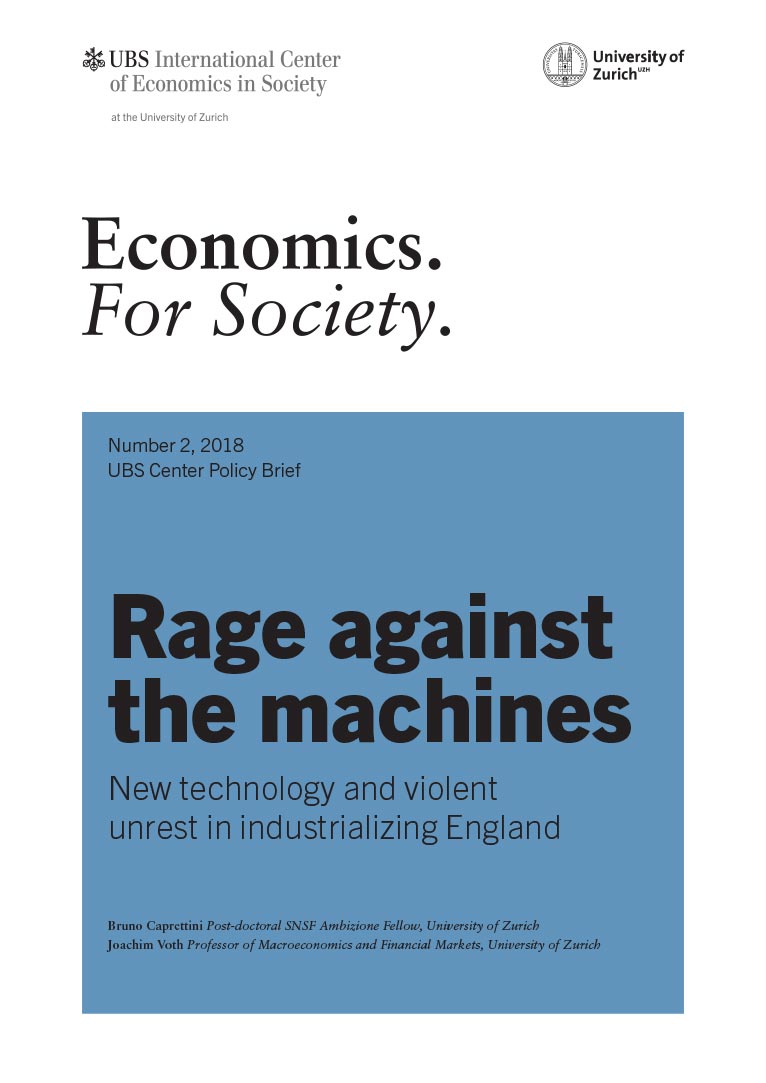
Press
Der Feind, die Maschine Finanz und Wirtschaft vom 12.11.2018 lesen
Conclusions
Over the last 200 years, new machines have increasingly replaced humans, and output per capita has surged more than ten-fold in most industrialized countries. At the same time, working hours have decreased from around 3,500 hours per year to around 2,000 for full-time employees, and an ever-smaller part of human life is spent working (Voth, 2001).
While the enormous increase in output per head as a result of technological change has contributed to rising living standards, it has also led to sharp declines in demand for less skilled labor. Our research examines the extent to which the replacement of workers by technology in this way can lead to ‘rage against the machines’.
The results suggest that in one of the most dramatic cases of labor unrest in recent history, labor-saving technology played a key role. While the past may not be an accurate guide to future upheavals, evidence from the days of Captain Swing serve as a reminder of how disruptive new, labor-saving technologies can be in economic, social and political terms.
If technology-induced job losses are rapid and affect a large part of the workforce, the risk of unrest can quickly become serious. New technologies may increase output overall, but the gains are not necessarily distributed equally – and the losers do not always suffer in silence.
For societies to adopt technology more effectively, enhancing productivity and wealth overall, they need ways to cushion the blow. This might be done either by offering alternative employment in thriving sectors or by providing minimum income guarantees.
This UBS Center Policy Brief summarizes ‘Rage Against the Machines: Labor-Saving Technology and Unrest in England, 1830-32’ by Bruno Caprettini and Joachim Voth.
Over the last 200 years, new machines have increasingly replaced humans, and output per capita has surged more than ten-fold in most industrialized countries. At the same time, working hours have decreased from around 3,500 hours per year to around 2,000 for full-time employees, and an ever-smaller part of human life is spent working (Voth, 2001).
While the enormous increase in output per head as a result of technological change has contributed to rising living standards, it has also led to sharp declines in demand for less skilled labor. Our research examines the extent to which the replacement of workers by technology in this way can lead to ‘rage against the machines’.
Callouts
In detail
The history of economic growth over the last 250 years is also the history of job destruction. Since the start of the Industrial Revolution, new machinery has wiped out countless jobs and replaced millions of workers.
Mechanization has also transformed the economy – since the 1800s, it turned agriculture from the main source of employment into a marginal sector (Crafts, 1985). More recently, job losses have spread to manufacturing and service jobs: computers today perform many routine tasks that used to give work to thousands of people, from telephone operators to secretaries.
The seeds of destruction
The idea that capitalism holds the seeds of its own destruction is as old as the Industrial Revolution. David Ricardo, writing in 1821, added a whole chapter to his book on political economy, arguing that ‘the substitution of machinery for human labor, is often very injurious to the interests of the class of laborers.’ The idea that rapid technological change would immiserize the working class and ultimately lead to social instability was also at the core of Karl Marx's predictions.
More recently, Nobel laureate Wassily Leontief (1983) said that the ‘specter of technological unemployment that provoked Lancashire weavers into a revolt 170 years ago, but that receded after the demand for skilled workers needed to operate complex (but dumb) machines replaced the demand for unskilled physical labor, is here again. But there are good reasons to believe that this time it will not retreat’.
But until recently, textbook treatments of ‘technological unemployment’ generally downplayed the possibility of significant social and economic disruption (Summers, 2013). While there is growing evidence that the replacement of humans with machines for routine tasks can lead to dislocation in the labor market (Autor et al, 2003), empirical support for the idea that technology-induced unemployment creates social unrest is conspicuously absent.
Even classic historical examples of technology-induced unrest, such as the famous Luddite attacks on industrial machines and the Captain Swing riots in industrializing England, have been called into question. Joel Mokyr and colleagues (2015), for example, suggest that in the ‘Luddite (1811-16) and Captain Swing (1830-32) riots, the role actually played by the concerns of laborers about being replaced by machinery has been greatly exaggerated.’
But if the new machines were not the cause of protest in the case of the Swing riots, why did workers put them at the center of their protests? Why did the Swing rioters ask their masters to destroy the new threshing machines themselves – and why did they proceed to break these machines and set them on fire when the masters refused to do it?
While previous research has proposed alternative explanations for the outbreak of the Swing riots – emphasizing an influx of Irish laborers, spillovers from the 1830 revolution in Paris and discontent about the administration of the Poor Law – we believe that the role of new technologies should be returned to center stage.
Our study collects new evidence on the spread of labor-saving technology in industrializing England. We show that it is associated with unrest on a substantial scale, and we demonstrate that there is indeed a causal connection between the introduction of the new machines and social unrest during the Swing riots.
The Captain Swing riots
Between the summer of 1830 and the summer of 1832, riots swept through the English countryside. Over no more than two years, 3,000 riots broke out – by far the largest case of popular unrest in England since 1700. During the riots, rural laborers burned down farmhouses, expelled overseers of the poor and sent threatening letters to landlords and farmers signed by the mythical character known as Captain Swing. Most of all, workers attacked and destroyed threshing machines.
Threshing machines were used to thresh grain, especially wheat. Until the end of the 1700s, threshing grain was done manually and it was the principal form of employment in the countryside during the winter months. Starting from the Napoleonic Wars (1803-1815), threshing machines spread across England, replacing workers. Horse-driven or water-powered threshers could finish in a matter of weeks a task that would have normally kept workers busy for months. Their use arguably depressed the wages of rural workers.
Eventually, in the summer of 1830, rural workers revolted in the Swing riots. Figure 1 gives an overview of the riots, using data from Holland (2005). While almost the entire country saw some kind of unrest, riots were concentrated in the South and South East of England, as well as in East Anglia. Moreover, even within regions, we observe wide variation in the incidence of riots, with areas with and without incidents located immediately adjacent to one another.
Measuring the spread of a new technology
To see if the adoption of labor-saving technology played an important role in fanning the flames of discontent, we collect new data on the adoption of threshing machines by examining farm advertisements in local English newspapers. Whenever a farm was for sale or its lease came up, such ads would list in great detail all the relevant characteristics of the property, from the size of the plot to the farmhouse and any machinery that went with it – including threshing machines.
We analyze data from 60 newspapers over the period from 1800 to 1830: a total of 118,758 articles of all kinds. Among these, we find 549 ads in 466 parishes that mentioned the presence of a threshing machine. Especially in the years after the end of the Napoleonic Wars, the number of ads mentioning threshing machines surged. Figure 2 plots the location and intensity of threshing machine uptake, as documented in ads.
The impact on unrest
A very simple statistic shows the change in the frequency of riots. In places where no ads for farms with threshing machines were published, the probability of a riot was 14%; in places with threshing machines, it was 26% or almost two times higher. When we focus on attacks on threshing machines or other agricultural capital equipment, the averages are lower but the relative difference is greater: 3% to 6.4%.
This suggests a large effect of new technology adoption on social instability. The places that saw the highest probability of unrest were also the ones with the highest adoption rates of threshing machines. But this relationship need not be causal. For example, it could be that areas with more newspapers carried more ads for threshing machines, and also had better coverage of riots.
We rule out this possibility by showing that while riot probabilities seem to decline with distance from the place of publication of a newspaper, the same is not true for ads – proximity to a newspaper location is not a good predictor of coverage by farm ads. And looking only at places no further than 50km from the nearest town with a newspaper, we find exactly the same effects.
Why technology adoption varied
A crucial question is why some places adopted the new technology before others. If take-up were driven by factors that could also directly influence unrest, we would not identify a clean effect of labor-saving machines on unrest. The estimates may also be biased downwards if landlords feared unrest, and consequently introduced fewer machines. To pin down causality and gauge magnitudes correctly, we look at the geographical location of parishes and the nature of their soil.
In particular, we look at two factors that made the adoption of the new technology more likely:
- The suitability of a region for wheat cultivation.
- The availability of sufficient water power.
For technological reasons, early threshing machines were only useful for threshing wheat; other grains, such as rye and barley, could not be threshed economically by early machines (Hobsbawm and Rudé, 2014). We examine soil suitability for wheat, as established by the Food Administration Organization (FAO). The FAO classifies all the world's land by suitability for various crops. We use modern-day data on England's soil to see how suitable different parishes were for the cultivation of wheat.
When we compare the maps of technology adoption with FAO wheat suitability data, we notice a great degree of overlap. Where the land is good for wheat, according to the FAO, farmers bought a lot more threshing machines. Importantly, the part of the variation driven by soil characteristics also predicts unrest: this is apparent on the map of England in Figure 3, where the areas that are more suitable for wheat (in green) are also those that experienced more unrest.
Not all wheat-producing areas were equally likely to adopt the new machines. Where water power was available in abundance, the new technology was more attractive. Based on geological data on the volume and direction of water flowing in a parish, we create an index of suitability for the use of water power: the accumulation flow. In combination, wheat suitability and accumulation flow are strong predictors of the adoption of threshing machines.
Moreover, we also show that the higher the suitability for wheat, and the more water is available for driving machinery, the greater the level of unrest. The three panels in the lower half of Figure 3 visualize the relationship between riots and the availability of water power in three separate regions of England. They reveal that within relatively homogeneous agricultural areas, riots were more common where more water flowed. This makes it more likely that machine adoption actually caused political unrest.
Unrest in 1830 also had negative long-term effects. Where unrest broke out, farmers subsequently avoided installing new machines – and not just threshing machines. In addition, inventive activity went down. Looking at patent data, we find that the further a parish was from violent riots and unrest in 1830, the higher the patenting rate – a pattern that was not visible in the data prior to 1830.
What could have been done to avoid the unrest?
Outside options mattered. Where workers could easily work elsewhere because their agricultural parish was relatively close to a large, thriving urban labor market, the new machines did not spell trouble. In contrast, the more remote a parish and the less vibrant the next market town, the higher the risk of instability.
We also find some suggestive evidence that England's embryonic welfare state helped to keep the social peace. Under the Poor Law, support for poor people varied at the local level. The more generous a parish was, the lower the correlation between threshing machines and unrest.
The history of economic growth over the last 250 years is also the history of job destruction. Since the start of the Industrial Revolution, new machinery has wiped out countless jobs and replaced millions of workers.
Mechanization has also transformed the economy – since the 1800s, it turned agriculture from the main source of employment into a marginal sector (Crafts, 1985). More recently, job losses have spread to manufacturing and service jobs: computers today perform many routine tasks that used to give work to thousands of people, from telephone operators to secretaries.
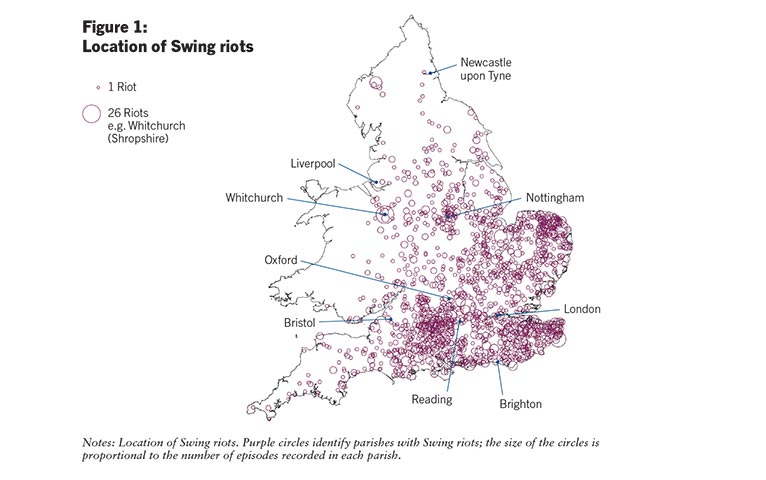
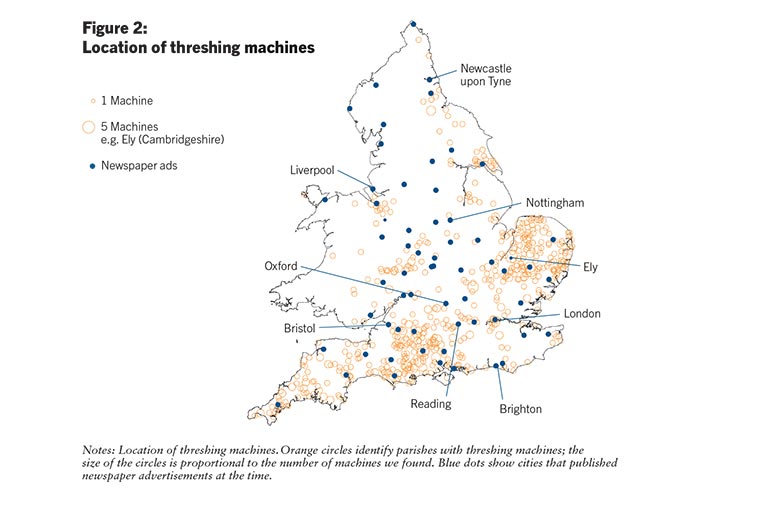
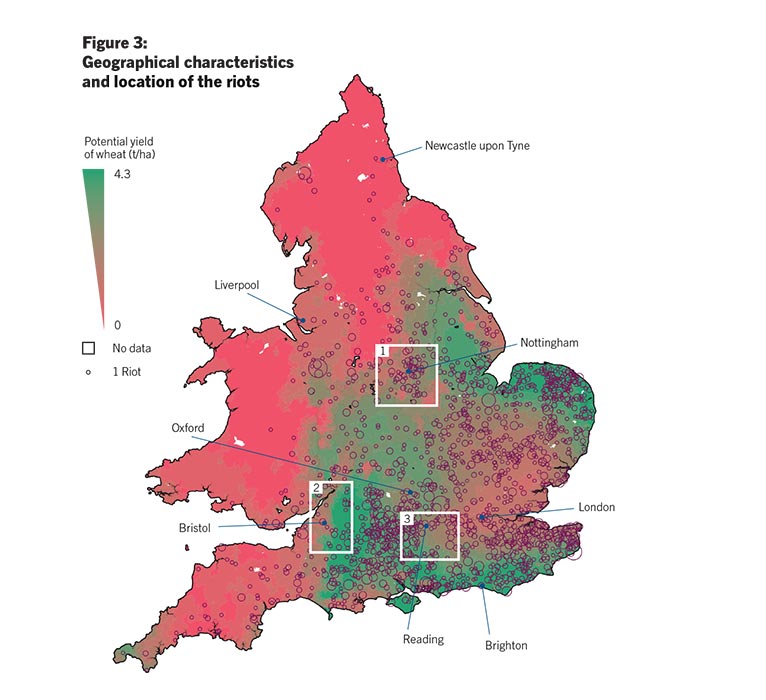
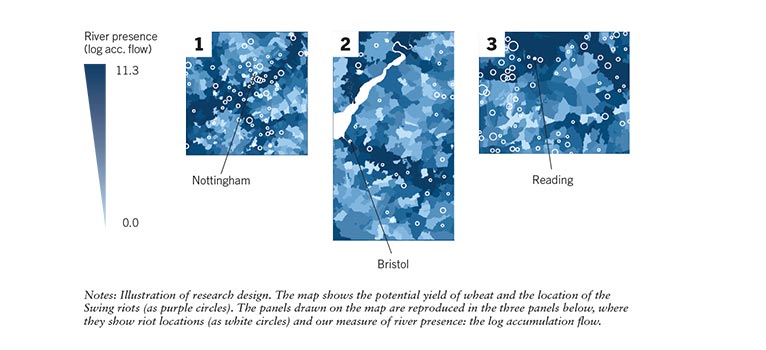
Further reading
Autor, David, Frank Levy and Richard Murnane (2003) ‘The Skill Content of Recent Technological Change: An Empirical Exploration’, Quarterly Journal of Economics 118(4): 1279-1333.
Crafts, Nicholas (1985) British Economic Growth during the Industrial Revolution, Oxford University Press.
Hobsbawm, Eric, and George Rudé (2014) Captain Swing, Verso (first published in 1969).
Holland, Michael (ed.) (2005) Swing Unmasked: The Agricultural Riots of 1830 to 1832 and Their Wider Implications, FACHRS Publishing.
Leontief, Wassily (1983) ‘Technological Advance, Economic Growth, and the Distribution of Income’, Population and Development Review 9(3): 403-10.
Mokyr, Joel, Chris Vickers and Nicolas Ziebarth (2015) ‘The History of Technological Anxiety and the Future of Economic Growth: Is This Time Different?’, Journal of Economic Perspectives 29(3): 31–50.
Ricardo, David 1821 (1996) Principles of Political Economy and Taxation, Great Minds Series, Prometheus Books.
Summers, Lawrence (2013), ‘Economic Possibilities for Our Children’, NBER Reporter.
Voth, Joachim (2001) Time and Work in England 1750-1830, Oxford University Press.
Authors
Bruno Caprettini is a post-doctoral fellow at the Department of Economics of the University of Zurich. He works on economic history and development economics. In August 2017, he received an SNF Ambizione grant for the project “Structural change- lessons from the present and from the past.” Structural change is the movement of labor out of agriculture. In his research, he studies episodes of structural change that happened in the past or in recent years.
Joachim Voth received his PhD from Oxford in 1996. He works on financial crises, long-run growth, as well as on the origins of political extremism. He has examined public debt dynamics and bank lending to the first serial defaulter in history, analysed risk-taking behaviour by lenders as a result of personal shocks, and the investor performance during speculative bubbles. Joachim has also examined the deep historical roots of anti-Semitism, showing that the same cities where pogroms occurred in the Middle Age also persecuted Jews more in the 1930s; he has analyzed the extent to which schooling can create radical racial stereotypes over the long run, and how dense social networks (“social capital”) facilitated the spread of the Nazi party. In his work on long-run growth, he has investigated the effects of fertility restriction, the role of warfare, and the importance of state capacity. Joachim has published more than 80 academic articles and 3 academic books, 5 trade books and more than 50 newspaper columns, op-eds and book reviews. His research has been highlighted in The Economist, the Financial Times, the Wall Street Journal, the Guardian, El Pais, Vanguardia, La Repubblica, the Frankfurter Allgemeine, NZZ, der Standard, der Spiegel, CNN, RTN, Swiss and German TV and radio.
Bruno Caprettini is a post-doctoral fellow at the Department of Economics of the University of Zurich. He works on economic history and development economics. In August 2017, he received an SNF Ambizione grant for the project “Structural change- lessons from the present and from the past.” Structural change is the movement of labor out of agriculture. In his research, he studies episodes of structural change that happened in the past or in recent years.
Joachim Voth received his PhD from Oxford in 1996. He works on financial crises, long-run growth, as well as on the origins of political extremism. He has examined public debt dynamics and bank lending to the first serial defaulter in history, analysed risk-taking behaviour by lenders as a result of personal shocks, and the investor performance during speculative bubbles. Joachim has also examined the deep historical roots of anti-Semitism, showing that the same cities where pogroms occurred in the Middle Age also persecuted Jews more in the 1930s; he has analyzed the extent to which schooling can create radical racial stereotypes over the long run, and how dense social networks (“social capital”) facilitated the spread of the Nazi party. In his work on long-run growth, he has investigated the effects of fertility restriction, the role of warfare, and the importance of state capacity. Joachim has published more than 80 academic articles and 3 academic books, 5 trade books and more than 50 newspaper columns, op-eds and book reviews. His research has been highlighted in The Economist, the Financial Times, the Wall Street Journal, the Guardian, El Pais, Vanguardia, La Repubblica, the Frankfurter Allgemeine, NZZ, der Standard, der Spiegel, CNN, RTN, Swiss and German TV and radio.